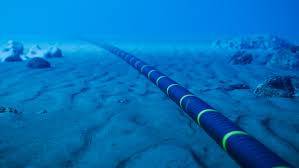The Growing Threat to Undersea Cables That Carry Internet Data
When we think about the internet, we usually imagine data flying through the air between satellites and wireless signals. But in reality, a vast amount of our global communication relies on undersea cables, hidden deep beneath the ocean. These fibre-optic cables are the unseen backbone of the internet, carrying more than 95% of global data traffic. They connect continents, allowing us to send emails, stream videos, conduct business, and communicate across the globe in real time. However, these cables are facing a growing threat, and that could have serious consequences for our connected world.
What Are Undersea Cables?
Undersea cables are long, thin strands of fiber-optic material that are laid across the ocean floor. They stretch for thousands of miles, linking countries and continents together. These cables are buried under layers of protection, including steel armor and waterproof materials, to prevent damage from natural forces like ocean currents or wildlife. Despite these measures, undersea cables are more vulnerable than you might think.
Why Are Undersea Cables Important?
Without these cables, the internet as we know it wouldn’t exist. They carry data at incredible speeds, supporting everything from streaming services and financial transactions to global communication between businesses and governments. For instance, if you're sending an email from the United States to Europe, that data is likely travelling through these undersea cables.
Imagine a world without access to the internet for even a few hours—businesses would halt, stock markets could crash, and communication would be severely disrupted. That’s why these cables are so vital, and their protection is increasingly important.
Growing Threats to Undersea Cables
Unfortunately, undersea cables are facing new and evolving threats that could compromise global connectivity. These threats come in many forms:
Accidental Damage: The most common threat to undersea cables comes from accidents. Fishing nets, ship anchors, and even natural disasters like earthquakes can damage the cables. While repairs can be made, they can take days or even weeks, causing major disruptions to internet service.
Intentional Sabotage: There is growing concern about the risk of intentional damage to undersea cables. In recent years, experts have warned that state actors or terrorist groups could target these cables to disrupt global communication. The cables are largely unprotected, and finding the location of these vital lines isn’t difficult for those with the right tools and knowledge.
Cybersecurity Risks: Some threats to undersea cables don’t involve physical damage. Hackers and state-sponsored groups may attempt to tap into these cables to intercept sensitive data, which could lead to privacy breaches or even espionage. Though efforts are made to encrypt the data travelling through these cables, the risks remain.
Climate Change: Rising sea levels and increasing storm activity due to climate change may also threaten undersea cables. Coastal erosion could expose cables, leaving them vulnerable to damage. Additionally, shifts in ocean currents and ecosystems could create new challenges for maintaining these lines.
What Happens If a Cable Is Cut?
When an undersea cable is damaged, the impact can be felt across the globe. Since most regions rely on a limited number of these cables, a break can lead to internet slowdowns, outages, or even complete loss of service in some areas. Businesses, financial institutions, and governments could all be affected by a cable cut, leading to economic losses and communication breakdowns.
While there are usually backup cables that can carry the load, they may not be enough to handle all of the traffic, especially in regions where connectivity is limited.
Protecting Our Undersea Cables
As the threat to undersea cables grows, so too does the need for better protection. Governments and private companies are working to safeguard these critical lines in several ways:
Increased Security: There is a push to improve the physical security of cables, including monitoring cable locations and using advanced detection systems to identify threats like ships or submarines that may get too close.
Redundancy: Many tech companies are investing in additional cables to create redundant systems. This means that if one cable is damaged, data can be quickly rerouted through another, minimising disruptions.
International Cooperation: Since undersea cables cross international waters, it’s important for countries to work together to ensure their protection. International agreements and collaborations are essential to safeguarding this global infrastructure.
Conclusion
Undersea cables are the invisible threads that connect our digital world, but they are facing growing risks. Whether from accidents, sabotage, or even natural disasters, the threat to these cables is real and could have serious consequences for global communication and commerce. Protecting this vital infrastructure is crucial to ensuring that our interconnected world remains stable and secure. As the digital age continues to evolve, so too must our efforts to safeguard the technologies that keep us connected.


